Hello and welcome,
Earlier today, we released the final report resulting from a more than year-long independent inquiry into St. John’s Seminary conducted by former U.S. Attorney Donald K. Stern, with the assistance of Attorney Doug Salvesen and others at the firm Yurko, Salvesen & Remz.
The seminary review has been a long and arduous process and has brought to light serious deficiencies that needed correcting. In truth, I believe we have a much stronger seminary as a result of the review and the changes that have already been made.
The report does not indicate that any illegal activities, sexual abuse or harassment have occurred, and we are relieved that the report clearly states that the problems it did find have been episodic and not systemic. Problems around the use of alcohol, clear policies concerning fraternization and how the staff should accompany our seminarians during their formation are in the process of being developed, as well as a stronger oversight role for the Board of Directors.
Unfortunately, what the report cannot communicate are all the good things that are taking place at St. John’s. There is a very high level of satisfaction among the students who are glad to be doing their formation at the seminary. This year, the archdiocese ordained 14 fine priests, the largest class in 20 years.
Even the criticism leveled against certain priests on the faculty cannot gainsay the fact that those same men have made many positive contributions to St. John’s and the life of the Church. They are faith-filled priests who have dedicated their lives to the Church, and they are beloved by the parishioners they serve and by many in the seminary community. There have been serious mistakes, there have been flaws, but we must not demonize anyone. At the same time, we are all very grateful to Interim Rector Father Stephen Salocks, Interim Vice Rector Father Tom Macdonald, and all of the staff and faculty whose dedication and commitment have earned them the gratitude and respect of all.
On my way back from last week’s meeting of the U.S. Conference of Catholic Bishops, I stopped in New York to celebrate the Mass of Investiture for the Order of Malta on Friday.
Our Boston members of the Order of Malta are part of the American Association, which is based in New York. Though I usually do not attend the investiture, Cardinal Dolan was in Rome, so he asked me to celebrate the Mass in his place.
I was very happy to celebrate the Mass in the newly refurbished St. Patrick’s Cathedral. In my remarks, I reminded everyone that the Cathedral of the Holy Cross is also newly refurbished but is larger than St. Patrick’s. (That certainly got a rise out of the New Yorkers!)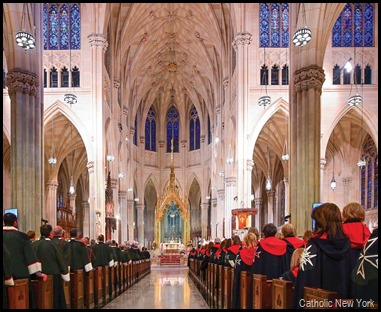
But St. Patrick’s certainly is an iconic landmark, and it was wonderful to celebrate Mass there with the Knights and Dames of Malta and to be present for the investiture of our new Boston members of the Order.
Sunday morning, we celebrated our annual Red Mass for members of the legal profession at the Seaport Chapel.
The tradition of celebrating a Red Mass dates back to the Middle Ages and is a Mass of the Holy Spirit celebrated to open the court’s term. The Mass takes its name from the red vestments worn by the clergy for the liturgy.
Here in Boston, as in many places around the country, we continue to observe this ancient custom. It is organized by the Catholic Lawyers Guild of the Archdiocese of Boston and is attended by judges, lawyers, law students and others involved in the practice of law. 




We were very pleased to be joined by about 25 law students from a number of universities who joined us for the Mass. 
With Father George Salzman and a number of students from Harvard Law school
Following the Mass, the members of the Lawyers Guild hold a brunch at which they present the Honorable Joseph R. Nolan Award. This year’s honoree was Dwight Duncan who is a professor at the University of Massachusetts Law School.

As the keynote speaker, Dwight offered a very nice reflection on the vocation of those in the legal profession.
Then, Sunday afternoon, I joined the Vietnamese community of the archdiocese for a Mass at the Cathedral of the Holy Cross in honor of the Feast of the Vietnamese Martyrs.
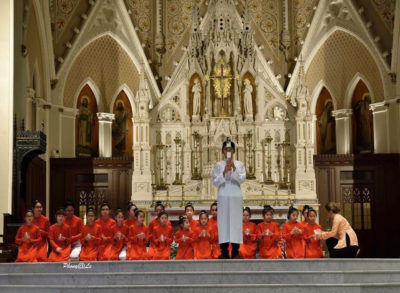
Before the Mass, they presented a small play depicting the martyrdom of St. Andrew Dung-Lac, which was followed by a beautiful procession with the relics of the saints.
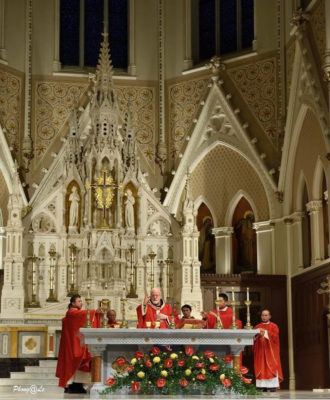
It was the first time that we have had this Mass since the cathedral has been refurbished, and all the people seemed very excited to be there for it.
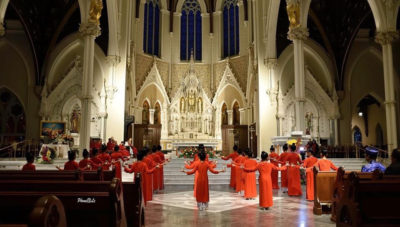
Monday, I went to Charlestown to celebrate the 10th anniversary of the Good Shepherd School.
I was there with Father Jim Ronan for the opening of the school, so it was very nice to be back to join the children, teachers and parents to celebrate the school’s first 10 years. The school has been very successful and is a great blessing for Charlestown.
We had a prayer service at which Father Ronan, the principal and the head of the Board of Directors all addressed the people.




Afterwards, there was a lovely reception.
Tuesday, I went to Our Lady Help of Christians Church in Newton to celebrate the Catholic Schools Foundation’s annual Peter Lynch Scholars Mass. This is an extraordinary program that helps families to be able to have the advantages of a Catholic education.


Many of the children were accompanied by their principals and family members for this happy occasion. Also with us for the Mass were Peter Lynch, our Superintendent of Catholic Schools Tom Carroll, and Michael Reardon, president of the Catholic Schools Foundation. 


It is always a wonderful event, and seeing all those young people there really brought home what an impact the Catholic Schools Foundation is making on our Catholic schools.
Then, that evening, I went to St. Michael Parish in North Andover to celebrate a Mass to mark their 150th anniversary.
A number of priests who had served in the parish returned to join us for the Mass.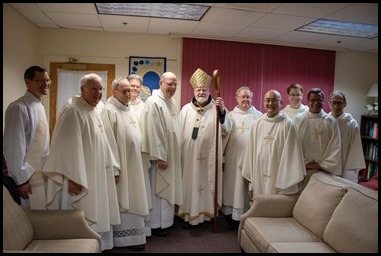
I believe the church holds about a thousand people, and it was just packed.


St. Michael’s is certainly a very vibrant community with a wonderful school, and it was a joy to be a part of this important event in their anniversary commemorations.
Thursday, we held our annual Fall Presbyteral Convocation at St. Julia’s Parish in Weston.
It was an opportunity for us to brief the priests on the St. John’s Seminary report.


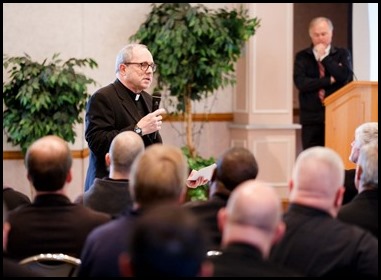
We also heard from Father Paul Soper on plans for an upcoming Eucharistic year.

I also shared with the priests some of my reflections on the Synod for the Amazon.


Until next week,
Cardinal Seán
